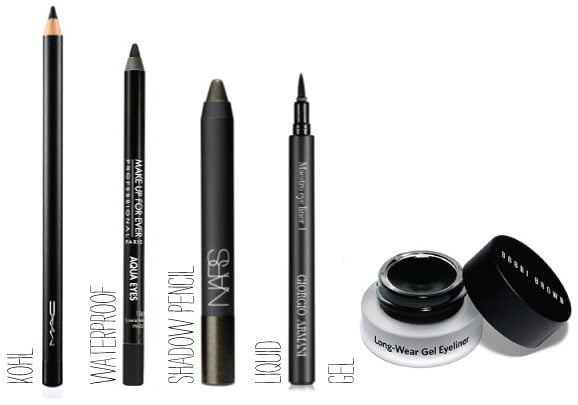
Eyeliner
Eyeliner, a fundamental cosmetic product, serves the purpose of defining and accentuating the eyes. It comes in various formulations, providing a myriad of options for creating distinct eye looks. Whether aiming for a subtle, natural appearance or opting for a bold and dramatic style, eyeliner stands out as a versatile tool that adds depth and definition to the eyes.
Ingredients
In order to provide the best possible texture, color payoff, and performance, eyeliner formulas are made up of a select group of ingredients. The following are some essential elements frequently seen in eyeliners:
Waxes: Using waxes gives eyeliner structure and helps it keep its shape while being applied.
Examples include carnauba and beeswax.
Pigments: Pigments are essential for giving eyeliner color and enabling users to create a variety of looks.
Examples are titanium dioxide and iron oxides.
Emollients: Emollients ensure that the eyeliner glides easily over the lash line and help to make application smooth and simple. Examples are shea butter and jojoba oil.
Thickeners: By controlling the texture of the eyeliner, role thickeners help keep it from becoming overly thick or runny. Examples: Different kinds of clay.
Preservatives: To ensure the product’s safety and shelf life, preservatives are added to stop the growth of germs and other microbes. Examples are parabens and phenoxyethanol.
Oxidants: To guard against free radical damage to the sensitive skin surrounding the eyes, certain eyeliners contain antioxidants. Examples are extract of rosemary and vitamin E.
Humectant substances: Function: Humectants aid in moisture retention, preventing the eyeliner from drying out and preserving its comfort level on the skin. Examples are hyaluronic acid and glycerin.
Film Forming Agent: Film-forming agents aid in the eyeliner’s skin-adherence and long-wearing qualities.
Examples include PVP (polyvinylpyrrolidone) and Acrylates Copolymer.
Talc and Silica: The inclusion of these minerals may improve the eyeliner’s function and texture.
Flavors and Fragrances: To create a pleasing sensory experience, some eyeliners may include flavorings or perfumes.
Examples include different scent chemicals.
Packaging and Design
Eyeliners come in a variety of packaging types, such as pencils, gels, and liquids, each tailored to a certain application preference. Designs vary in complexity to accommodate a wide spectrum of consumer tastes, from sleek and minimalist to more ornate.
Texture and Scent
Texture
Eyeliner pencils often have a creamy, silky feel that makes applying them easy and gives a precise line.
Liquid Eyeliners: Because liquid eyeliners frequently have a fluid viscosity, they can be used to create sharp lines and vibrant colors.
Gel Eyeliner: Gels have a creamy, velvety texture that strikes a compromise between liquid and pencil formulas, allowing for easy application and all-day wear.
Pen Eyeliners: Pen-style eyeliners, which often have a smooth and controlled application, combine the accuracy of liquid liners with the ease of a pen.
Kohl Eyeliners: Kohl eyeliners work well for smeared or smokey eye effects because of their soft, blendable nature.
Scent
Eyeliners are usually designed to be odorless, emphasizing the product’s utilitarian features. However, the chemicals in some eyeliners may give them a faint cosmetic smell. In general, fragrance is kept to a minimum to prevent irritation, especially near the sensitive eye area.
Experience with Eyeliner
For me, applying eyeliner has been a satisfying experience. Because eyeliners are so versatile, I’ve been able to try a variety of looks, from more dramatic looks for special events to subtle improvements for everyday wear.
Similar Products
Other products that resemble eyeliners are gel eyeliners, eye pencils, and eyeshadows that are used as liners. Every product has distinct benefits and features of its own.
Pros
- Adaptable to producing a variety of eye appearances.
- Accentuates and defines the eyes.
- Comes in varied formulas to suit a range of tastes.
Cons
- For accurate application, practice might be necessary.
- Certain formulas could smear or fade during the course of the day.
- Removing some waterproof formulations can be difficult.
Frequently Asked Questions About Eyeliner
1. How can I select the best eyeliner for my particular eye shape?
When choosing an eyeliner, take your eye shape into account. While liquid eyeliner are excellent for precision and bold lines, pencil liners look wonderful when applied lightly.
2. Is it okay to apply eyeliner to my waterline?
A lot of eyeliners are made to work with waterlines, yes. For greater staying power, go for a product that is long-wearing or waterproof.
3. What eyeliner is most appropriate for beginners?
Because pencil eyeliners are so forgiving to apply and so simple to use, they are frequently suggested for novices.
4. What are some ways to stop my eyeliner from smudging?
Use an eyeshadow primer before applying eyeliner, and then use a complementary eyeshadow to set the liner. Additionally, waterproof formulations can aid in avoiding smearing.
5. Is there a particular method for applying winged eyeliner?
Build the wing gradually by beginning with little strokes. Find the angle that best suits your eye shape by practicing and using tape or a guideline for accuracy.
6. Can I apply eyeliner to the edge of my lower lashes?
You may define and accentuate your eyes by using eyeliner on the lower lash line. To create a more dramatic impression, choose for bolder tints or softer hues.
7. How can I take off eyeliner without irritating my eyes?
Apply micellar water or a mild makeup remover to a cotton pad. Before wiping, let the eyeliner dissolve for a few seconds by holding the pad over the liner.
8. What distinguishes liquid eyeliners from pencil eyeliners?
Liquid eyeliners give sharp lines and vibrant color, but pencil eyeliners give a softer, smeared look. The decision is based on the preferred makeup look.

Leave a Reply